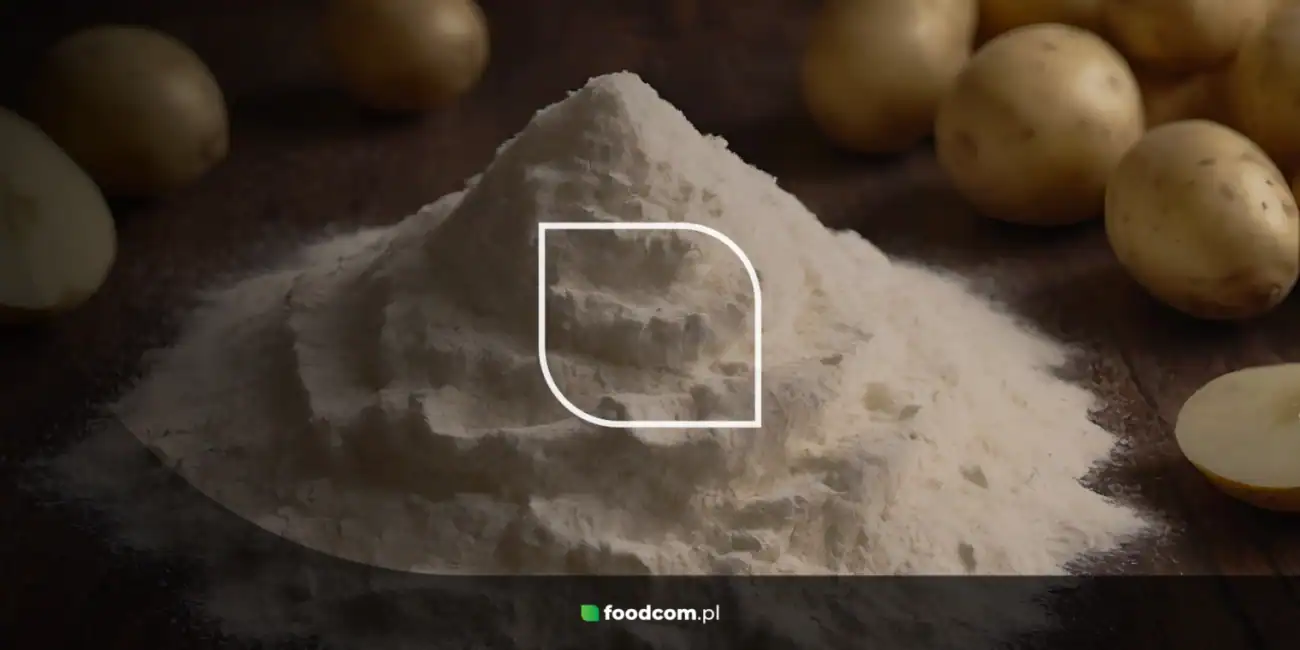What is Modified Starch E1442
Modified Starch E1442, also known as Acetylated Distarch Adipate, is a food-grade starch that has been chemically modified to improve its performance in a wide range of applications. The modification involves introducing acetyl groups and creating cross-links within the starch molecules. This process changes its functionality compared to native starch, giving it greater stability under different processing and storage conditions.
From a chemical standpoint, E1442 is produced by treating starch with acetic anhydride for acetylation and adipic anhydride for cross-linking. This dual modification makes it more resistant to heat, acid, and shear forces, and it helps prevent undesirable changes such as syneresis (water separation) in finished products.
In terms of food safety, E1442 is approved for use by major regulatory authorities including the U.S. Food and Drug Administration (FDA), the European Food Safety Authority (EFSA), and Codex Alimentarius. It complies with international food additive standards and is considered safe when used within prescribed limits.
Common starch sources used for producing E1442 include:
- Corn starch – widely available, neutral flavor
- Potato starch – high clarity, smooth texture
- Tapioca starch – excellent freeze-thaw stability and clean mouthfeel
Because of its reliable performance and regulatory approval, E1442 is widely used in both retail food products and industrial food manufacturing.
How is E1442 Modified
E1442, also called acetylated distarch adipate, is made by taking regular starch and putting it through two main steps: acetylation and cross‑linking.
- Acetylation: A small amount of acetyl groups are added to the starch molecules. This helps keep the starch granules from sticking together and improves flexibility.
- Cross‑linking: Starch chains are linked together using adipic acid. This creates a stronger internal structure, so the granules hold up better during cooking and processing.
Why this matters:
These changes make E1442 far more stable than native starch. It can handle:
- High heat – works well in cooking, pasteurization, and sterilization
- Shear stress – resists breaking down during mixing or pumping in production lines
- Acidic environments – ideal for products like salad dressings or sauces with vinegar and tomatoes
- Freeze‑thaw cycles – keeps texture from breaking down after freezing and thawing
Quick Comparison – Native Starch vs E1442 Modified Starch
| Feature | Native Starch | E1442 Modified Starch |
|---|---|---|
| Heat stability | Low | High |
| Shear resistance | Low | High |
| Acid stability | Low | High |
| Freeze‑thaw performance | Poor | Excellent |
| Texture after storage | Gummy or watery | Smooth and stable |
In short, the modification process makes E1442 a reliable thickener and stabilizer for foods that face intense processing or storage in both hot and cold conditions.
Properties of Modified Starch E1442

Modified starch E1442, also called acetylated distarch adipate, is known for its stable and predictable performance in food production. It keeps its texture and function under a wide range of processing conditions, making it ideal for both hot and cold applications.
Key physical and chemical properties:
- Viscosity – Creates consistent thickness without breaking down during cooking or mixing.
- Gelatinization temperature – Higher than native starch, giving it more heat tolerance.
- Gel clarity – Produces smooth, uniform gels with minimal cloudiness, depending on the source (corn, potato, tapioca).
Resistance to stress:
- Holds up well under high heat, mechanical shear, and acidic environments.
- Maintains quality during pasteurization, sterilization, and long mixing times.
Functional benefits in food:
- Thickening – Delivers reliable body and mouthfeel to sauces, soups, and fillings.
- Stabilizing – Keeps ingredients from separating in dressings, batters, and beverages.
- Emulsifying aid – Supports oil-and-water blends in dairy and prepared foods.
This combination of properties makes E1442 a go-to choice for manufacturers aiming for consistent performance in large-scale production without losing quality over time.
Behavior of Modified Starch E1442 in Hot Conditions

When Modified Starch E1442 (acetylated distarch adipate) is used in hot applications, it reacts differently than regular starch. Under heat, the starch granules absorb water and gelatinize, creating a smooth and stable paste. Thanks to its acetylation and cross-linking, E1442 can hold its structure during intense cooking processes like boiling, pasteurization, or sterilization without breaking down.
In hot foods, this heat stability means there’s less thinning, lumping, or separation, even if the recipe goes through high-shear mixing. That’s why you’ll often find it in:
- Sauces and gravies – keeps viscosity consistent and prevents watery separation
- Soups – maintains body and thickness through long cooking times
- Bakery fillings – resists breakdown during baking and reheating
- Canned or retorted foods – holds texture during sterilization
The result is a product with improved mouthfeel, rich texture, and a balanced, stable thickness from first bite to last. For food processors in the U.S., this means fewer formulation headaches, more consistent batches, and less risk of texture loss under hot processing conditions.
Behavior of Modified Starch E1442 in Cold Conditions
Modified starch E1442, also called acetylated distarch adipate, is well-known for its strong performance in cold applications. One of its key features is its cold water swelling ability—it can hydrate and thicken without the need for heating. This makes it ideal for recipes where you can’t or don’t want to apply heat, like instant dressings or no-cook desserts.
It also has excellent freeze-thaw stability, meaning it resists water separation (syneresis) after being frozen and thawed. This is a major advantage in frozen ready meals, ice cream bases, or prepared sauces that go through multiple freeze-thaw cycles. Another benefit is its ability to minimize retrogradation, which is the process that makes starch-based foods turn hard or gritty over time in cold storage. This keeps products smooth and maintains their original texture for longer.
Common cold-use applications in the U.S. include:
- Refrigerated foods: dips, salad dressings, dairy desserts
- Frozen products: fruit fillings, ready-to-eat meals, frozen sauces
- Chilled desserts: puddings, custards, mousse bases
By maintaining viscosity and smooth mouthfeel even after long storage, E1442 helps extend shelf-life and quality, ensuring products stay consistent from the day they’re made until they’re consumed.
Differences Between Cold and Hot Application Uses of E1442

Modified starch E1442 (acetylated distarch adipate) works differently in hot and cold conditions because heat affects starch structure in a way that cold storage does not. Knowing these variations helps fine-tune recipes for consistent quality.
Structural and Functional Differences
| Condition | Key Functional Traits | Best Use Examples |
|---|---|---|
| Hot Applications | Holds viscosity during cooking, resists thinning from heat and shear, stable in acidic recipes | Sauces, soups, gravies, bakery fillings |
| Cold Applications | Maintains thickness without heating, high freeze-thaw stability, prevents water separation | Refrigerated dressings, frozen pies, dairy desserts |
- Hot use → The starch granules swell fully during heating, giving a smooth, glossy texture that stays stable through pasteurization or sterilization.
- Cold use → Modification allows partial swelling or hydration without heat, reducing retrogradation and ice crystal damage during freezing.
Tips for Best Results
- For hot recipes, hydrate at the right temperature and avoid overcooking to maintain texture.
- For cold recipes, use the right concentration to avoid a gummy mouthfeel.
- Adjust pH and fat content in the recipe for maximum stability.
Industry Application Examples
- Dairy: Cold-process puddings, stabilized yogurts, heat-processed custards.
- Meat: Hot gravies for ready meals, chilled deli meat glazes.
- Beverages: Heat-processed creamy drinks, cold smoothie bases.
Advantages of Using Taichy Modified Starch E1442
Taichy Modified Starch E1442 is designed to handle both hot and cold food applications without losing performance. This makes it a go-to option for manufacturers who need a single starch that works across different processing conditions.
Key advantages include:
- Tailored for Hot and Cold Processing – Works equally well in cooking, baking, freezing, or chilled storage.
- Consistent Quality – Every batch meets strict food-grade standards for uniform performance.
- Stable Texture and Viscosity – Holds thickness and smoothness through heating, cooling, and freeze-thaw cycles.
- Custom Formulations – Taichy offers E1442 variations suited for specific applications like sauces, soups, chilled desserts, and dressings.
- Technical Support – Access to product experts for formulation advice and troubleshooting.
| Feature | Benefit in Food Production |
|---|---|
| High stability in heat and cold | Same texture in hot soups and frozen meals |
| Freeze-thaw resistance | No water separation after freezing |
| Uniform viscosity | Predictable results for large batches |
| Custom options | Matches product-specific needs |
| Expert guidance | Faster product development |
With its balance of performance, consistency, and tailored support, Taichy Modified Starch E1442 helps streamline production while ensuring the end product always meets quality expectations.
How to Choose the Right Modified Starch for Your Product

Picking the right modified starch, like E1442 acetylated distarch adipate, comes down to your product’s recipe, processing, and storage needs. The wrong choice can lead to texture breakdown, separation, or shorter shelf life. Here’s what to keep in mind.
Key Factors to Consider
- Temperature range – Will your product face high heat (cooking, pasteurization) or cold storage/freezing? E1442 works well in both but especially shines in freeze-thaw stability.
- Texture goals – Are you looking for a smooth, glossy sauce, a creamy dairy texture, or a firm gel? Starch type impacts mouthfeel and appearance.
- Processing stress – Shear from mixing, acid in recipes, or sterilization can break down weaker starches. E1442 handles these demands better than native starch.
- Storage conditions – If your product will be frozen, shipped across climates, or stored for months, pick a starch with proven retrogradation resistance like E1442.
Comparing E1442 to Other Modified Starches
| Starch Type | Heat Stability | Cold Stability | Freeze-Thaw Resistance | Common Uses |
|---|---|---|---|---|
| E1442 Acetylated Distarch Adipate | High | High | Excellent | Soups, sauces, frozen meals |
| Cross-linked Starch | Very High | Medium | Medium | Canned foods, bakery fillings |
| Acetylated Starch | Medium | High | Good | Salad dressings, dairy desserts |
| Native Starch | Low | Low | Poor | Limited use, basic thickening |
Practical Advice from Taichy Experts
- For frozen or refrigerated products, E1442 is often the safest choice for keeping texture intact.
- For high-heat applications like retorted soups or gravies, combine E1442 with a high-heat-resistant starch for best performance.
- Always test in your actual process—lab results don’t always mirror plant conditions.
- Taichy offers custom starch blends to hit your exact viscosity, stability, and cost targets.
Frequently Asked Questions FAQs
Is E1442 safe for all food applications
Yes. Modified starch E1442 (acetylated distarch adipate) is approved by the FDA and other global food safety authorities for use in food. It’s considered safe when used within the regulated limits. You’ll find it in products ranging from sauces to frozen meals without any special consumer warnings.
Can E1442 replace other thickeners
It can replace many common starches and gums, especially when you need better heat stability, freeze-thaw resistance, and consistent texture. Compared to native starch, it holds up better in tough processing like canning, UHT, or frozen storage. But whether it’s a direct swap depends on your recipe, desired texture, and cost targets.
Shelf life and storage conditions of products containing E1442
E1442 itself is stable in dry form for at least 18–24 months when stored:
- In a cool, dry place
- Away from direct sunlight and moisture
- In sealed packaging to avoid contamination or clumping
Once it’s in a food product, shelf life depends more on the other ingredients and processing method. In frozen or refrigerated products, E1442 helps maintain smooth texture and reduce water separation during storage.


